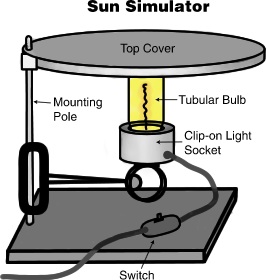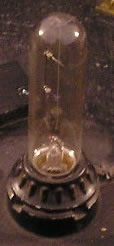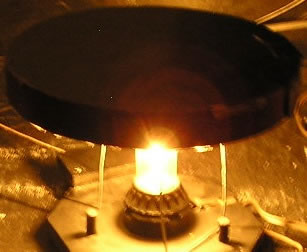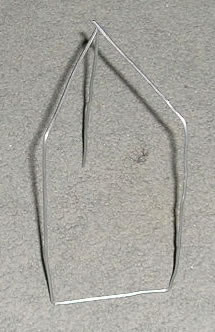Materials for Moons of the Solar System
1. Diurnal Motion and Moon Phases
Your planetarium must have the capabilities of diurnal motion and Moon phases with proper position relative to an image of the Sun.
2. Sun-Moon Simulator
(a) In the center (or front) of the planetarium, mount a short unfrosted tubular light bulb (about 25 to 40 watts) for simulating the Sun. Such a clear, single filament bulb is necessary to create crisp shadows on the model Moons. Ideally, supply electrical power to the bulb through a dimmer switch. Place a top shade over the bulb to prevent reflection of white light from the dome.




(b) The model Moons can be white (or gray) polystyrene balls mounted on sticks. It is helpful to store the balls in boxes that volunteers can help hand out during the show.
Note: polystyrene balls work way better than styrofoam balls due to the fact that styrofoam less dense, more fragile and more translucent than polystyrene.
For larger audiences, rather than balls, people can simply shape their hand into a ball (otherwise known as a fist). This is not as visually satisfying as the polystyrene spheres, but a whole lot easier to do.
A less desirable alternative to the physical Sun-Moon simulation is to use the Alternative Moon Phase Movies (download link in the Media section).
3. Light Pointers
You will need at least two light pointers (one bright and one dim) or a single light pointer with variable brightness. For ideas, see LED Pointers Made Easy or John French’s LED light pointer (made with an old lens from a slide projector, PVC fitting, and superbright LED).
4. Reading Lights for the Students
In our permanent planetarium, we have 11-watt night-light orange bulbs under the cove, with shades so they shine down on the audience. This is very convenient, because visitors can see their “Tracking Jupiter’s Moons” charts and look back at the sky freely. The program can also be done by turning up the atmosphere and the Sun for people to mark their charts, and then turning it down for the next observation. Another option is to provide LED clipboards.
5. Sound effect: Countdown and Rocket Launch Noise
This is a very exciting touch for beginning the tour of moons. The bigger and deeper the rocket launch sound, the better the effect. Students can fasten their “safety belts” and imagine they are taking off in a rocket ship. Such an audio segment can be found on sound effects CDs, tapes, record albums, or on free worldwide web sites. Optional: You can have your own “sunset music” to play when you make the sun set near the beginning of the program.
6. “Tracking Jupiter’s Moons” Data Sheet
For each student, have a pencil and a copy of the
“Tracking Jupiter’s Moons” Data Sheet.

